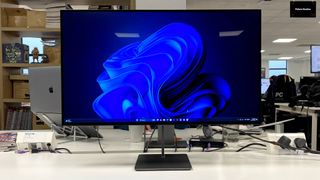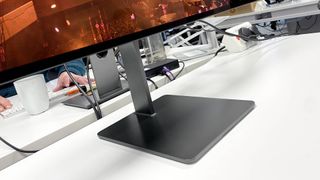Formerly known as Eve, Dough is the kind of company you want to like. It's an independent startup with a self-styled community angle rather than a sprawling, faceless corporate entity. And that shows in its monitors, both for better and worse. Notably, there have been some serious missteps when it comes to actually shipping its products. Arguably, that goes with the startup territory.
That startup mentality is also absolutely evident with the Dough Spectrum Black 32 OLED, the brand's very latest PC monitor. It ups Dough's ante to fully 32 inches of glorious 4K OLED action and, just like the original Spectrum, you sense the effort and investment, in terms of design and careful attention to elements like the design aesthetic and build quality, that's gone into this new OLED panel. You just don't see that from the bigger brands.
Where models from more mainstream monitor makers tend to feel a bit cheap, plasticky and mass produced, even at this premium end of the market, the Dough 32 OLED sports a lush metal rear chassis and a gorgeous, beautifully engineered alloy stand, albeit that latter feature is an optional $100 extra.
Add in the slick Corning Gorilla Glass screen cover and minimalist design and you have easily the most physically desirable 4K OLED we've yet reviewed. It makes most of the alternatives feel like cheap, disposable toys.
Dough Spectrum Black 32 OLED specs

Screen size: 32-inch
Resolution: 3,840 x 2,160
Brightness: 275 nits full screen, 1,000 nits max HDR
Response time: 0.03 ms
Refresh rate: 240 Hz
HDR: DisplayHDR 400 True Black
Features: LG WOLED panel, Adaptive Sync, 1x DisplayPort 1.4, 2x HDMI 2.1, USB-C with 100 W PD, Gorilla Glass 3
Price: $1,099 (without stand) | £1,299 (Hub model)
It's also mostly well specified. Dough has gone for the LG WOLED option as opposed to Samsung's QD-OLED tech. There are pros and cons to both panel types, but the LG panel in 4K format is the company's third generation WOLED technology and, importantly, it closes the gap to Samsung for full-screen brightness.
Actually, if anything it's a bit brighter full-screen for white tones, though QD-OLED probably still has the edge for color brightness. That's because WOLED, as the name implies, has an additional white subpixel to boost brightness that obviously does its best work with white tones.
Anyway, Dough has specced this panel up at 240Hz like most 4K OLEDs and its 275 nit full-screen and 1,000 nit peak HDR (in a 3% window) brightness ratings are largely par for the course, as is the claimed 0.03ms response performance.

To that you can add both HDMI 2.1 and DisplayPort 1.4 connectivity, plus a USB-C interface with 100 W of power delivery for slick single-cable connectivity, although the 100 W rating, while at least equal to that of most comparable displays, means that there's not enough power for a genuine gaming laptop. The only arguable exception to that is the new HP Omen Transcend 32 OLED with its 140 W USB-C interface, which is just about enough for some low-spec RTX 4060 laptops.
Anywho, while there is USB-C for video input and device charging, there's no USB hub for peripheral connectivity. At least, there isn't with this model which goes for $1,099, or $1,199 with the stand. A so-called "Hub" model which adds that functionality and a few other features is coming, but will be priced at $1,299 without the stand. Ouch.

Out of the box, the sRGB calibration in SDR mode looks great.
That's a pity, because the USB-C interface without a hub rather undermines the whole single-cable connectivity notion. If you're not going to have a hub, it probably makes sense to ditch USB-C altogether and hit a lower price point. Still, at $999 with a stand, the Dough Spectrum Black OLED is actually pretty attractively priced given the overall feature set and clear build and design quality edge it has over the competition. If it performs well, it could be a no brainer as our pick of the current 32-inch 4K bunch.
Sadly, that's not quite the case. Out of the box, the sRGB calibration in SDR mode looks great, with accurate colors and plenty of punch with the brightness cranked up. There is a little ABL-driven brightness variation depending on how much of the screen is being ignited. But it doesn't distract to anything like the extent that ABLs or automatic brightness limiters did with earlier generation LG WOLED-equipped monitors.

The Gorilla Glass cover is likewise very sweet, enabling a sense of heightened contrast but without excessive reflectivity. In fact, it makes for the best glossy implementation of an OLED we've seen. You really would have to be using this monitor in incredibly bright ambient conditions to choose the matte version Dough will also be offering starting at $899 with no stand and no USB-C port.
The problems begin when you enable HDR.
As an SDR panel, then, this thing really pops, the pixel density thanks to the 4K resolution is fab, and then you're getting all the usual OLED upsides including ridiculously fast response times, great viewing angles and perfect per-pixel lighting. However, the problems begin when you enable HDR.
For starters, despite updating to the latest firmware that supposedly fixes an HDR brightness issue, our review sample wasn't producing the full HDR performance.

Meanwhile, SDR tone mapping in HDR mode is essentially broken. That means you have to switch between SDR and HDR modes depending on content type. Not the end of the world? Nope. But it's a problem lots of HDR monitors used to have but latterly far fewer exhibit and contributes to a broader impression of a monitor that's not quite ready for retail availability.

On that note, the USB-C interface in its current state is essentially broken and only works intermittently with the multiple laptops with which we tested. This should be a fairly straight forward fix for Dough, just like the SDR tone mapping in HDR mode. But as we write this review, actual customers are receiving monitors and they really shouldn't be shipping out with these fairly basic flaws.
Buy if...
✅ You want the best looking 4K OLED around: The Spectrum Black is beautifully built and designed.
Don't buy if...
❌ You want something polished and free from flaws: Dough needs to put a little more work into the calibration and ironing bugs with the USB-C interface.
This is, frankly, a little disappointing. At $999 with the stand, this could be our favourite 4K OLED. The design and build is lovely and the LG WOLED panel is fundamentally fabulous. Fix the SDR tone mapping and the USB-C interface and this will be a killer product. As it is, the Dough Spectrum Black 32 very much a hold rather than a buy.
If you're interested, our advice is to keep a weather eye on the Dough Reddit forum and jump in when it's clear all the issues have been sorted. They very likely will be, at which point the Dough Spectrum Black 32 OLED with Gorilla Glass will be very appealing, albeit at a price.
Ideally, we'd like to see a Gorilla Glass version with the arguably redundant USB-C ripped out and offered for about $100 less. That would be a very compelling proposition. As it is, we'd counsel caution for now. In its current state, the Dough Spectrum Black 32 OLED isn't quite ready to be bought.

 3 weeks ago
15
3 weeks ago
15








 English (US) ·
English (US) ·